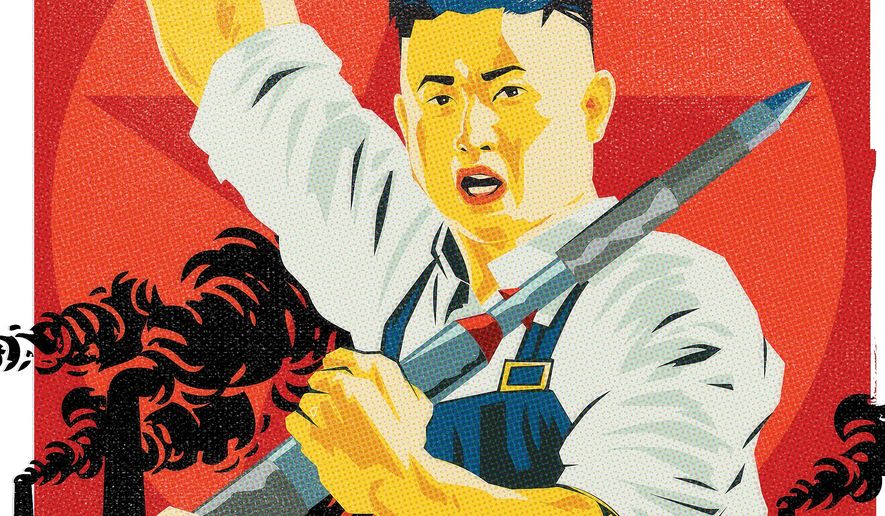OPINION:
America can do anything but America can’t do everything, at least not within a four-year time frame. That suggests that the American president — any American president — needs to prioritize.
In 2011, President Obama decided that the Muslim world should no longer be a top American priority. Against the advice of key members of his national security team, he decided to withdraw all U.S. troops from Iraq and do nothing about the growing turmoil in Syria. He expressed confidence that coalition forces would soon “begin to draw down” in Afghanistan. As for al Qaeda, it was “on the path to defeat.”
“So make no mistake,” he announced, “the tide of war is receding.” With those words, he began what was called his “pivot to Asia.”
The long-term challenge in that part of the world, then as now, came from China. But the most imminent threat, then as now, came from North Korea, a nation firmly under the jackboot of a brutal dynasty friendly toward regimes that despise America (e.g., Syria and Iran).
In a major address in November 2011, Mr. Obama promised to “act firmly against any proliferation activities by North Korea.” Curiously, he said not a word about Pyongyang’s own nuclear weapons and missile programs and the peril they posed to South Korea, Japan and the United States itself.
Those programs were to have been stopped through diplomacy, starting with the Agreed Framework President Clinton concluded in 1994. But time after time Pyongyang pocketed generous American financial inducements, then promptly violated the obligations it had undertaken.
President George W. Bush cited North Korea as a component of the “axis of evil” but failed to mitigate either its intentions or capabilities. President Obama’s policy toward North Korea was known as “strategic patience,” which sounds better than “kicking the can down the road.” Step by malevolent step, North Korea’s nuclear arsenal has grown and its ballistic-missile program has advanced.
In recent years, “supreme leader” Kim Jong-un has doubled the size of his facility for enriching uranium. Last year, he conducted two nuclear tests (earlier tests were in 2006, 2009 and 2013) and tested a submarine-launched ballistic missile as well. Last month, he launched an intermediate-range ballistic missile that may be able to carry a nuclear warhead. This month, he launched four ballistic missiles, simulating an attack on a U.S. base in Japan. And over the weekend, he claimed to have test-fired a new type of high-thrust rocket engine.
The fear and expectation is that he will next test an intercontinental ballistic missile (ICBM) capable of delivering a nuclear weapon to the continental United States. Within three years, Mr. Kim could be in possession of miniaturized nuclear weapons that can be fitted atop such missiles. I’d argue that makes a persuasive case that President Trump is correct to now view North Korea as a high priority.
“Let me be very clear,” Secretary of State Rex Tillerson said in South Korea last week, “the policy of strategic patience has ended. We are exploring a new range of diplomatic, security and economic measures. All options are on the table.”
What I hope that means: All instruments of American power will now come into play to prevent the North Korean threat from maturing. That will include much tougher sanctions on the regime and perhaps on China, too, if its rulers continue to refuse to rein in their rogue client; tacitly encouraging the prospect of South Korea and Japan acquiring their own nuclear weapons — an eventuality China adamantly opposes; ratcheting up cyberstrikes against North Korea’s missile program; and, not least, credibly threatening to use force to destroy North Korea’s nuclear weapons facilities if all else fails.
Also: The United States has begun deploying in South Korea a Terminal High Altitude Area Defense System (THAAD) capable of destroying North Korean missiles. Ship-borne Aegis Combat Systems that can do the same are being positioned in the region as well.
These are steps in the right direction. The pity is that had the Obama administration prioritized North Korea years ago, the U.S. could have been in a much stronger position today.
Not long after Mr. Obama took office in 2009, Pyongyang provocatively launched a multi-stage rocket and conducted its second nuclear test. In June of that year, in what was almost certainly a fraudulent election, the bellicose Mahmoud Ahmadinejad was re-elected president of Iran, answerable only to Supreme Leader Ali Khamenei, whose animus toward America has never wavered.
These and other developments made America’s allies nervous. In August, then-Secretary of State Hillary Clinton attempted to reassure them. The U.S., she pledged, would provide “a defense umbrella.”
That prompted an op-ed in The Wall Street Journal coauthored by Ilan Berman, vice president of the American Foreign Policy Council and me. We applauded Mrs. Clinton but pointed out that to actually put an effective shield in place would require a substantial investment in missile defense.
Mr. Obama had other priorities. But the goal we proposed then still makes sense now: “a comprehensive architecture that would include antimissile systems on land, on the seas, and in space.”
Much of the necessary technology has already been developed. Other useful technologies (e.g., boost-phase interceptors and lasers capable of shooting down long-range missiles) could be brought online over the next few years. Would this be challenging? Yes. Like putting a man on the moon? Not nearly.
As we said back in 2009, once deployed, such a layered system, would “make Iranian, North Korean and other foreign missiles useless.” The U.S. would have the means to prevent them from reaching their intended victims.
An America that is becoming great again should prioritize such a goal — and then achieve it.
• Clifford D. May is president of the Foundation for Defense of Democracies and a columnist for The Washington Times.




Please read our comment policy before commenting.